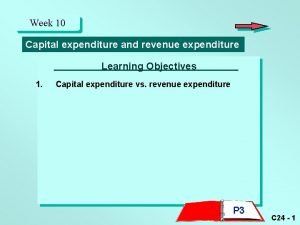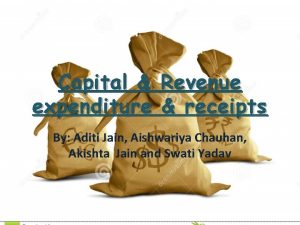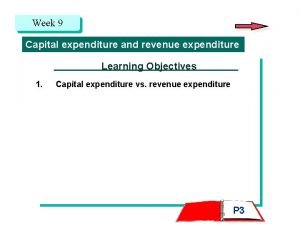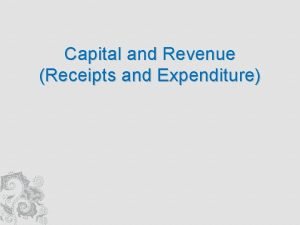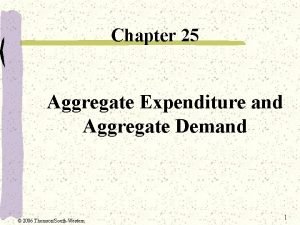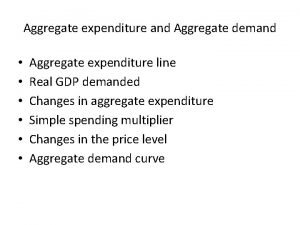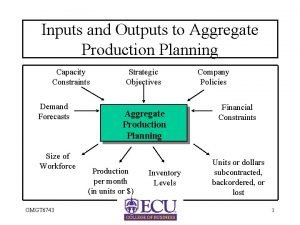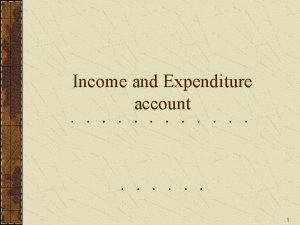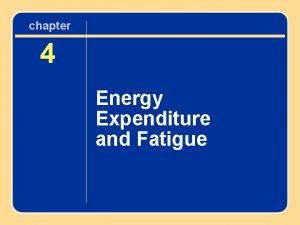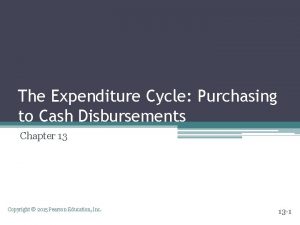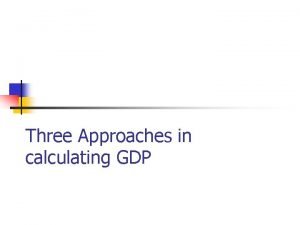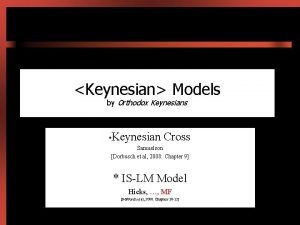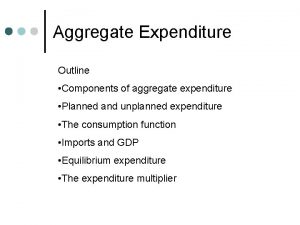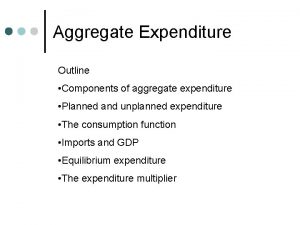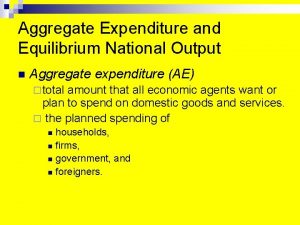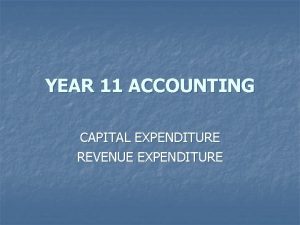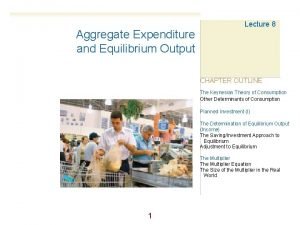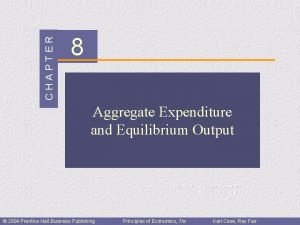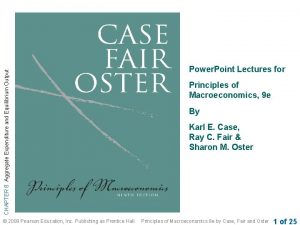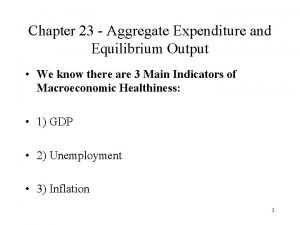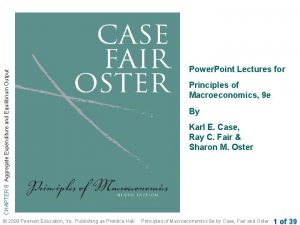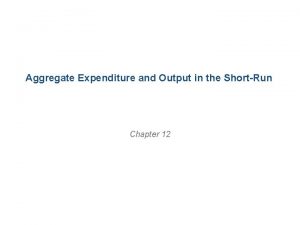CHAPTER 23 Aggregate Expenditure and Output in the











































































- Slides: 75


CHAPTER 23 Aggregate Expenditure and Output in the Short Run Chapter Outline and Learning Objectives 23. 1 The Aggregate Expenditure Model 23. 2 Determining the Level of Aggregate Expenditure in the Economy 23. 3 Graphing Macroeconomic Equilibrium 23. 4 The Multiplier Effect 23. 5 The Aggregate Demand Curve Appendix: The Algebra of Macroeconomic Equilibrium © 2013 Pearson Education, Inc. Publishing as Prentice Hall 2 of 75

Fluctuating Demand Helps—and Hurts—Intel and Other Firms • Because of its dependence on computer sales, Intel is vulnerable to the swings of the business cycle, laying off workers and experiencing falling revenues during recessions. • As Intel recovered in 2010 from revenues lost during the 2007 -2009 recession, its revenue grew through the first half of 2011 due to increased demand for the parts it sells to computer manufacturers. • Intel suffered again during the slow economic growth in 2011, but layoffs were not limited to technology firms. • These firms were cutting production and employment as a result of the sluggish growth of total spending, or aggregate expenditure. • AN INSIDE LOOK on page 838 discusses the expected rebound in sales in the restaurant industry following the recession of 2007– 2009. © 2013 Pearson Education, Inc. Publishing as Prentice Hall 3 of 75

Economics in Your Life When Consumer Confidence Falls, Is Your Job at Risk? Suppose that while attending college, you work part time, assembling desktop computers for a large computer company. One morning, you read in the local newspaper that consumer confidence in the economy has fallen and, consequently, many households expect their future income to be dramatically less than their current income. See if you can answer these questions by the end of the chapter: Should you be concerned about losing your job? What factors should you consider in deciding how likely your company is to lay you off? Aggregate expenditure (AE) Total spending in the economy: the sum of consumption, planned investment, government purchases, and net exports. © 2013 Pearson Education, Inc. Publishing as Prentice Hall 4 of 75

The Aggregate Expenditure Model 23. 1 LEARNING OBJECTIVE Understand how macroeconomic equilibrium is determined in the aggregate expenditure model. © 2013 Pearson Education, Inc. Publishing as Prentice Hall 5 of 75

Aggregate expenditure model A macroeconomic model that focuses on the short-run relationship between total spending and real GDP, assuming that the price level is constant. In any particular year, the level of GDP is determined mainly by the level of aggregate expenditure. Aggregate Expenditure In 1936, the English economist John Maynard Keynes published a book, The General Theory of Employment, Interest, and Money, that systematically analyzed the relationship between changes in aggregate expenditure and changes in GDP. © 2013 Pearson Education, Inc. Publishing as Prentice Hall 6 of 75

Keynes identified four components of aggregate expenditure that together equal GDP: • Consumption (C). This is spending by households on goods and services. • Planned investment (I). This is planned spending by firms on capital goods and by households on new homes. • Government purchases (G). This is spending by local, state, and federal governments on goods and services. • Net exports (NX). This is spending by foreign firms and households on goods and services produced in the United States minus spending by U. S. firms and households on goods and services produced in other countries. © 2013 Pearson Education, Inc. Publishing as Prentice Hall 7 of 75

So, we can write Aggregate expenditure = Consumption + Planned investment + Government purchases + Net exports or AE = C + I + G + NX The Difference between Planned Investment and Actual Investment Notice that planned investment spending, rather than actual investment spending, is a component of aggregate expenditure. Inventories Goods that have been produced but not yet sold. Actual investment will equal planned investment only when there is no unplanned change in inventories. In this chapter, we will use I to represent planned investment. © 2013 Pearson Education, Inc. Publishing as Prentice Hall 8 of 75

Macroeconomic Equilibrium For the economy as a whole, macroeconomic equilibrium occurs where total spending, or aggregate expenditure, equals total production, or GDP: Aggregate expenditure = GDP Adjustments to Macroeconomic Equilibrium When aggregate expenditure is greater than GDP, inventories will decline, and GDP and total employment will increase. When aggregate expenditure is less than GDP, inventories will increase, and GDP and total employment will decrease. Only when aggregate expenditure equals GDP will the economy be in macroeconomic equilibrium. © 2013 Pearson Education, Inc. Publishing as Prentice Hall 9 of 75

Table 23. 1 The Relationship between Aggregate Expenditure and GDP If. . . aggregate expenditure is equal to GDP aggregate expenditure is less than GDP aggregate expenditure is greater than GDP then. . . and. . . inventories are unchanged the economy is in macroeconomic equilibrium. inventories rise GDP and employment decrease. inventories fall GDP and employment increase. When economists forecast that aggregate expenditure is likely to decline and that the economy is headed for a recession, the federal government may implement macroeconomic policies in an attempt to head off the decrease in expenditure and keep the economy from falling into recession. © 2013 Pearson Education, Inc. Publishing as Prentice Hall 10 of 75

Determining the Level of Aggregate Expenditure in the Economy 23. 2 LEARNING OBJECTIVE Discuss the determinants of the four components of aggregate expenditure and define marginal propensity to consume and marginal propensity to save. © 2013 Pearson Education, Inc. Publishing as Prentice Hall 11 of 75

Table 23. 2 Components of Real Aggregate Expenditure, 2010 Expenditure Category Consumption Real Expenditure (billions of 2005 dollars) $9, 221 Planned investment 1, 715 Government purchases 2, 557 Net exports − 422 Each component is measured in real terms, meaning that it is corrected for inflation by being measured in billions of 2005 dollars. Net exports were negative because in 2010, as in most years since the early 1970 s, the United States imported more goods and services than it exported. © 2013 Pearson Education, Inc. Publishing as Prentice Hall 12 of 75

Consumption Figure 23. 1 Real Consumption follows a smooth, upward trend, interrupted only infrequently by brief recessions. © 2013 Pearson Education, Inc. Publishing as Prentice Hall 13 of 75

The following are the five most important variables that determine the level of consumption: • Current disposable income • Household wealth • Expected future income • The price level • The interest rate © 2013 Pearson Education, Inc. Publishing as Prentice Hall 14 of 75

Current Disposable Income Disposable income is the income remaining to households after they have paid the personal income tax and received government transfer payments. The main reason for the general upward trend in consumption shown in Figure 23. 1 is that disposable income has followed a similar upward trend. Household Wealth A household’s wealth is the value of its assets minus the value of its liabilities. A recent estimate of the effect of changes in wealth on consumption spending indicates that, for every permanent $1 increase in household wealth, consumption spending will increase by between 4 and 5 cents per year. Expected Future Income Most people prefer to keep their consumption fairly stable from year to year, even if their income fluctuates significantly. Current income explains current consumption well only when it is not unusually high or unusually low compared with expected future income. © 2013 Pearson Education, Inc. Publishing as Prentice Hall 15 of 75

The Price Level The price level measures the average prices of goods and services in the economy. Changes in the price level affect consumption mainly through their effect on the real value of household wealth. The Interest Rate Recall that the nominal interest rate is the stated interest rate on a loan or a financial investment, corrected for the effect of inflation by the real interest rate, which is the nominal interest rate minus the inflation rate. Consumption spending depends on the real interest rate because households are concerned with the payments they will make or receive after the effects of inflation are taken into account. Changes in the interest rate affect spending on durable goods more than they affect spending on services and nondurable goods because a high real interest rate increases the cost of spending financed by borrowing. © 2013 Pearson Education, Inc. Publishing as Prentice Hall 16 of 75

Making the Connection Do Changes in Housing Wealth Affect Consumption Spending? Housing wealth equals the market value of houses minus the value of loans people have taken out to pay for the houses. The figure shows the S&P/Case. Shiller index of housing prices, which represents changes in the prices of single-family homes. Because many macroeconomic variables move together, economists sometimes have difficulty determining whether movements in one are causing movements in another. My. Econ. Lab Your Turn: Test your understanding by doing related problem 2. 11 at the end of this chapter. © 2013 Pearson Education, Inc. Publishing as Prentice Hall 17 of 75

The Consumption Function Figure 23. 2 The Relationship between Consumption and Income, 1960– 2010 Panel (a) shows the relationship between consumption and income. The points represent combinations of real consumption spending and real disposable income for the years 1960 to 2010. In panel (b), we draw a straight line through the points from panel (a). The line, which represents the relationship between consumption and disposable income, is called the consumption function. The slope of the consumption function is the marginal propensity to consume. © 2013 Pearson Education, Inc. Publishing as Prentice Hall 18 of 75

Because changes in consumption depend on changes in disposable income, we can say that consumption is a function of disposable income. Consumption function The relationship between consumption spending and disposable income. Marginal propensity to consume (MPC) The slope of the consumption function: The amount by which consumption spending changes when disposable income changes. Using the Greek letter delta, ∆, to represent “change in, ” C to represent consumption spending, and YD to represent disposable income, we can write the expression for the MPC as follows: © 2013 Pearson Education, Inc. Publishing as Prentice Hall 19 of 75

For example, between 2006 and 2007, consumption spending increased by $208 billion, while disposable income increased by $228 billion. The marginal propensity to consume was, therefore: The value for the MPC tells us that households in 2007 spent 91 percent of the increase in their household income. We can also use the MPC to determine how much consumption will change as income changes: Change in consumption = Change in disposable income × MPC With an MPC of 0. 91, a $10 billion increase in disposable income will increase consumption by $10 billion × 0. 91, or $9. 1 billion. © 2013 Pearson Education, Inc. Publishing as Prentice Hall 20 of 75

The Relationship between Consumption and National Income Since the differences between GDP and national income are small and can be ignored without affecting our analysis, we will use these terms interchangeably. Disposable income is equal to national income plus government transfer payments minus taxes. Taxes minus government transfer payments are referred to as net taxes, so: Disposable income = National income − Net taxes We can rearrange the equation like this: National income = GDP = Disposable income + Net taxes © 2013 Pearson Education, Inc. Publishing as Prentice Hall 21 of 75

Figure 23. 3 The Relationship between Consumption and National Income Because national income differs from disposable income only by net taxes—which, for simplicity, we assume are constant— we can graph the consumption function using national income rather than disposable income. We can also calculate the MPC, which is the slope of the consumption function, using either the change in national income or the change in disposable income and always get the same value. The slope of the consumption function between point A and point B is equal to the change in consumption—$1, 500 billion— divided by the change in national income—$2, 000 billion—or 0. 75. © 2013 Pearson Education, Inc. Publishing as Prentice Hall 22 of 75

If we calculate the slope of the line in Figure 23. 3 between points A and B, we get a result that will not change whether we use the values for national income or the values for disposable income. Using the values for national income: Using the corresponding values for disposable income from the table: National income and disposable income differ by a constant amount, so changes in the two numbers always give us the same value. © 2013 Pearson Education, Inc. Publishing as Prentice Hall 23 of 75

Income, Consumption, and Saving For the economy as a whole, we can write the following: National income = Consumption + Saving + Taxes When national income increases, there must be some combination of an increase in consumption, an increase in saving, and an increase in taxes: Change in national income = Change in consumption + Change in saving + Change in taxes Using symbols, where Y represents national income (and GDP), C represents consumption, S represents saving, and T represents taxes, we can write the following: Y=C+S+T and ∆Y = ∆C + ∆S + ∆T To simplify, we can assume that taxes are always a constant amount, in which case ∆T = 0, so the following is also true: ∆Y = ∆C + ∆S © 2013 Pearson Education, Inc. Publishing as Prentice Hall 24 of 75

Marginal propensity to save (MPS) The amount by which saving changes when disposable income changes. We can measure the MPS as the change in saving divided by the change in disposable income, again safely ignoring the difference between national income and disposable income. If we divide the last equation on the previous slide by the change in income, ∆Y, we get an equation that shows the relationship between the marginal propensity to consume and the marginal propensity to save: or, 1 = MPC + MPS This equation tells us that when taxes are constant, the marginal propensity to consume plus the marginal propensity to save must always equal 1 because additional income not consumed must instead be saved. © 2013 Pearson Education, Inc. Publishing as Prentice Hall 25 of 75

Solved Problem 23. 2 Calculating the Marginal Propensity to Consume and the Marginal Propensity to Save Fill in the blanks in the following table. For simplicity, assume that taxes are zero. National Income and Real GDP (Y) Consumption (C) $9, 000 $8, 000 10, 000 8, 600 11, 000 9, 200 12, 000 9, 800 13, 000 10, 400 Saving (S) Marginal Propensity to Consume (MPC) Marginal Propensity to Save (MPS) — — Solving the Problem Step 1: Review the chapter material. © 2013 Pearson Education, Inc. Publishing as Prentice Hall 26 of 75

Solved Problem 23. 2 Calculating the Marginal Propensity to Consume and the Marginal Propensity to Save Fill in the blanks in the following table. For simplicity, assume that taxes are zero. National Income and Real GDP (Y) Consumption (C) Saving (S) Marginal Propensity to Consume (MPC) Marginal Propensity to Save (MPS) $9, 000 $8, 000 $1, 000 — — 10, 000 8, 600 1, 400 11, 000 9, 200 1, 800 12, 000 9, 800 2, 200 13, 000 10, 400 2, 600 Step 2: Fill in the table. We know that Y = C + S + T. With taxes equal to zero, this equation becomes Y = C + S. We can use this equation to fill in the “Saving” column. We can use the equations for the MPC and the MPS to fill in the other two columns: © 2013 Pearson Education, Inc. Publishing as Prentice Hall 27 of 75

Solved Problem 23. 2 Calculating the Marginal Propensity to Consume and the Marginal Propensity to Save Fill in the blanks in the following table. For simplicity, assume that taxes are zero. National Income and Real GDP (Y) Consumption (C) Saving (S) Marginal Propensity to Consume (MPC) Marginal Propensity to Save (MPS) $9, 000 $8, 000 $1, 000 — — 10, 000 8, 600 1, 400 0. 6 0. 4 11, 000 9, 200 1, 800 12, 000 9, 800 2, 200 13, 000 10, 400 2, 600 Step 2: Fill in the table. For example, to calculate the value of the MPC in the second row, we have: To calculate the value of the MPS in the second row, we have: © 2013 Pearson Education, Inc. Publishing as Prentice Hall 28 of 75

Solved Problem 23. 2 Calculating the Marginal Propensity to Consume and the Marginal Propensity to Save Fill in the blanks in the following table. For simplicity, assume that taxes are zero. National Income and Real GDP (Y) Consumption (C) Saving (S) Marginal Propensity to Consume (MPC) Marginal Propensity to Save (MPS) $9, 000 $8, 000 $1, 000 — — 10, 000 8, 600 1, 400 0. 6 0. 4 11, 000 9, 200 1, 800 0. 6 0. 4 12, 000 9, 800 2, 200 0. 6 0. 4 13, 000 10, 400 2, 600 0. 6 0. 4 Show that the MPC plus the MPS equals 1. Step 3: Show that the MPC plus the MPS equals 1. At every level of national income, the MPC is 0. 6 and the MPS is 0. 4. Therefore, the MPC plus the MPS is always equal to 1. My. Econ. Lab Your Turn: For more practice, do related problem 2. 13 at the end of this chapter. © 2013 Pearson Education, Inc. Publishing as Prentice Hall 29 of 75

Planned Investment Figure 23. 4 Real Investment is subject to larger changes than is consumption. Investment declined significantly during the recessions of 1980, 1981– 1982, 1990– 1991, 2001, and 2007– 2009. Note: The values are quarterly data, seasonally adjusted at an annual rate. © 2013 Pearson Education, Inc. Publishing as Prentice Hall 30 of 75

The four most important variables that determine the level of investment are: • Expectations of future profitability • Interest rate • Taxes • Cash flow © 2013 Pearson Education, Inc. Publishing as Prentice Hall 31 of 75

Expectations of Future Profitability Investment goods are long lived. The optimism or pessimism of firms about the economy is an important determinant of investment spending. Interest Rate Borrowing takes the form of issuing corporate bonds or receiving loans from banks. Because households and firms are interested in the cost of borrowing after taking into account the effects of inflation, investment spending depends on the real interest rate. Holding the other factors that affect investment spending constant, there is an inverse relationship between the real interest rate and investment spending: A higher real interest rate results in less investment spending, and a lower real interest rate results in more investment spending. © 2013 Pearson Education, Inc. Publishing as Prentice Hall 32 of 75

Taxes Firms focus on the profits that remain after they have paid taxes. The federal government imposes a corporate income tax on the profits corporations earn, which affects the after-tax profitability of investment spending. Investment tax incentives provide firms with tax reductions to increase their spending on new investment goods. Cash Flow Most firms use their own funds to finance spending. Cash flow The difference between the cash revenues received by a firm and the cash spending by the firm. Profit contributes the most to cash flow, which excludes noncash spending. The more profitable a firm is, the greater its cash flow and the greater its ability to finance investment. © 2013 Pearson Education, Inc. Publishing as Prentice Hall 33 of 75

Making the Connection Intel Tries to Jump Off the Roller Coaster of Information Technology Spending To help deal with declining sales during recessions, Intel began to develop memory chips in 2009 that could be used in portable consumer electronic devices. My. Econ. Lab Your Turn: Test your understanding by doing related problem 2. 14 at the end of this chapter. © 2013 Pearson Education, Inc. Publishing as Prentice Hall 34 of 75

Government Purchases Figure 23. 5 Real Government Purchases Government purchases grew steadily for most of the 1979– 2011 period, with the exception of the early 1990 s, when concern about the federal budget deficit caused real government purchases to fall for three years, beginning in 1992. Note: The values are quarterly data, seasonally adjusted at an annual rate. © 2013 Pearson Education, Inc. Publishing as Prentice Hall 35 of 75

Total government purchases include all spending by federal, local, and state governments for goods and services, excluding transfer payments by the federal government or pension payments by local governments because the government does not receive from these a good or service in return. Net Exports We can calculate net exports by taking the value of spending by foreign firms and households on goods and services produced in the United States and subtracting the value of spending by U. S. firms and households on goods and services produced in other countries. © 2013 Pearson Education, Inc. Publishing as Prentice Hall 36 of 75

Figure 23. 6 Real Net Exports Net exports were negative in most years between 1979 and 2011. Net exports have usually increased when the U. S. economy is in recession and decreased when the U. S. economy is expanding, although they fell during most of the 2001 recession. Note: The values are quarterly data, seasonally adjusted at an annual rate. © 2013 Pearson Education, Inc. Publishing as Prentice Hall 37 of 75

The following are three most important variables that determine the level of net exports: • The price level in the United States relative to the price levels in other countries • The growth rate of GDP in the United States relative to the growth rates of GDP in other countries • The exchange rate between the dollar and other currencies © 2013 Pearson Education, Inc. Publishing as Prentice Hall 38 of 75

The Price Level in the United States Relative to the Price Levels in Other Countries A slower increase in the U. S. price level than the price levels in other countries increases the demand for U. S. products relative to the demand foreign products, increasing net exports. The reverse happens during periods when the inflation rate in the United States is higher than the inflation rates in other countries. The Growth Rate of GDP in the United States Relative to the Growth Rates of GDP in Other Countries When incomes rise faster in the United States than in other countries, U. S. consumers’ purchases of foreign goods and services increase faster than foreign consumers’ purchases of U. S. goods and services, decreasing net exports. When incomes in the United States rise more slowly than incomes in other countries, net exports rise. The Exchange Rate between the Dollar and Other Currencies As the value of the U. S. dollar rises, the foreign currency price of U. S. products sold in other countries rises, and the dollar price of foreign products sold in the United States falls, so net exports will fall. Conversely, a decrease in the value of the dollar will increase net exports. © 2013 Pearson Education, Inc. Publishing as Prentice Hall 39 of 75

Graphing Macroeconomic Equilibrium 23. 3 LEARNING OBJECTIVE Use a 45°-line diagram to illustrate macroeconomic equilibrium. © 2013 Pearson Education, Inc. Publishing as Prentice Hall 40 of 75

The 45°-line diagram is sometimes referred to as the Keynesian cross because it is based on the analysis of John Maynard Keynes. Figure 23. 7 An Example of a 45°-Line Diagram The 45° line shows all the points that are equal distances from both axes. Points such as A and B, at which the quantity produced equals the quantity sold, are on the 45° line. Points such as C, at which the quantity sold is greater than the quantity produced, lie above the line. Points such as D, at which the quantity sold is less than the quantity produced, lie below the line. © 2013 Pearson Education, Inc. Publishing as Prentice Hall 41 of 75

Figure 23. 8 The Relationship between Planned Aggregate Expenditure and GDP on a 45°-Line Diagram Every point of macroeconomic equilibrium is on the 45° line, where planned aggregate expenditure equals GDP. At points above the line, planned aggregate expenditure is greater than GDP. At points below the line, planned aggregate expenditure is less than GDP. Although all points of macroeconomic equilibrium must lie along the 45° line, only one of these points will represent the actual level of equilibrium real GDP during any particular year, given the actual level of planned real expenditure. The aggregate expenditure function shows us the amount of planned aggregate expenditure that will occur at every level of national income, or GDP. © 2013 Pearson Education, Inc. Publishing as Prentice Hall 42 of 75

Figure 23. 9 Macroeconomic Equilibrium on the 45°-Line Diagram Macroeconomic equilibrium occurs where the aggregate expenditure (AE) line crosses the 45° line. The lowest upward-sloping line, C, represents the consumption function. The quantities of planned investment, government purchases, and net exports are constant because we assumed that the variables they depend on are constant. So, the total of planned aggregate expenditure at any level of GDP is the amount of consumption at that level of GDP plus the sum of the constant amounts of planned investment, government purchases, and net exports. We successively add each component of spending to the consumption function line to arrive at the line representing aggregate expenditure. © 2013 Pearson Education, Inc. Publishing as Prentice Hall 43 of 75

Figure 23. 10 Macroeconomic Equilibrium Macroeconomic equilibrium occurs where the AE line crosses the 45° line. In this case, that occurs at GDP of $10 trillion. If GDP is less than $10 trillion, the corresponding point on the AE line is above the 45° line, planned aggregate expenditure is greater than total production, firms will experience an unplanned decrease in inventories, and GDP will increase. If GDP is greater than $10 trillion, the corresponding point on the AE line is below the 45° line, planned aggregate expenditure is less than total production, firms will experience an unplanned increase in inventories, and GDP will decrease. © 2013 Pearson Education, Inc. Publishing as Prentice Hall 44 of 75

Showing a Recession on the 45°-Line Diagram Macroeconomic equilibrium can occur at any point on the 45° line. Ideally, we would like equilibrium to occur at potential GDP. At potential GDP, firms will be operating at their normal level of capacity, and the economy will be at the natural rate of unemployment. At the natural rate of unemployment, the economy will be at full employment: Everyone in the labor force who wants a job will have one, except the structurally and frictionally unemployed. For equilibrium to occur at the level of potential GDP, planned aggregate expenditure must be high enough. © 2013 Pearson Education, Inc. Publishing as Prentice Hall 45 of 75

Figure 23. 11 Showing a Recession on the 45°-Line Diagram When the aggregate expenditure line intersects the 45° line at a level of GDP below potential GDP, the economy is in recession. The figure shows that potential GDP is $10 trillion, but because planned aggregate expenditure is too low, the equilibrium level of GDP is only $9. 8 trillion, where the AE line intersects the 45° line. As a result, some firms will be operating below their normal capacity, and unemployment will be above the natural rate of unemployment. We can measure the shortfall in planned aggregate expenditure as the vertical distance between the AE line and the 45° line at the level of potential GDP. © 2013 Pearson Education, Inc. Publishing as Prentice Hall 46 of 75

The Important Role of Inventories Whenever planned aggregate expenditure is less than real GDP, some firms will experience unplanned increases in inventories. If firms do not cut back their production promptly when spending declines, they will accumulate inventories. Firms will have to sell their excess inventories before they can return to producing at normal levels, even if spending has already returned to normal levels. In fact, almost half of the sharp decline in real GDP during the first quarter of 2009 resulted from firms cutting production as they sold off unintended accumulations of inventories. © 2013 Pearson Education, Inc. Publishing as Prentice Hall 47 of 75

A Numerical Example of Macroeconomic Equilibrium We can capture some key features contained in the quantitative models that economic forecasters use by looking at several hypothetical combinations of real GDP and planned aggregate expenditure. Table 23. 3 Macroeconomic Equilibrium Real GDP (Y) Consumption (C) Planned Investment (I) Government Net Purchases Exports (G) (NX) Planned Aggregate Expenditure (AE) Unplanned Change in Real GDP Inventories Will … $8, 000 $6, 200 $1, 500 − $500 $8, 700 −$700 increase 9, 000 6, 850 1, 500 − 500 9, 350 − 350 increase be in equilibrium 10, 000 7, 500 1, 500 − 500 10, 000 0 11, 000 8, 150 1, 500 − 500 10, 650 +350 decrease 12, 000 8, 800 1, 500 − 500 11, 300 +700 decrease Note: The values are in billions of 2005 dollars Don’t Let This Happen to You Don’t Confuse Aggregate Expenditure with Consumption Spending Planned aggregate expenditure equals the sum of consumption spending, planned investment spending, government purchases, and net exports, not consumption spending by itself. My. Econ. Lab Your Turn: Test your understanding by doing related problem 3. 11 at the end of this chapter. © 2013 Pearson Education, Inc. Publishing as Prentice Hall 48 of 75

Solved Problem 23. 3 Determining Macroeconomic Equilibrium Fill in the blanks in the following table and determine the equilibrium level of real GDP. Real GDP (Y) Consumption (C) $8, 000 $6, 200 9, 000 Planned Investment (I) Government Purchases (G) Net Exports (NX) $1, 675 $− 500 6, 850 1, 675 − 500 10, 000 7, 500 1, 675 − 500 11, 000 8, 150 1, 675 − 500 12, 000 8, 800 1, 675 − 500 Planned Aggregate Expenditure (AE) Unplanned Change in Inventories Note: The values are in billions of 2005 dollars. Solving the Problem Step 1: Review the chapter material. Step 2: Fill in the missing values in the table. We can calculate the missing values in the last two columns by using two equations: Planned aggregate expenditure (AE) = Consumption (C) + Planned investment (I) + Government purchases (G) + Net exports (NX) and Unplanned change in inventories = Real GDP (Y) − Planned aggregate expenditure (AE) © 2013 Pearson Education, Inc. Publishing as Prentice Hall 49 of 75

Solved Problem 23. 3 Determining Macroeconomic Equilibrium Fill in the blanks in the following table and determine the equilibrium level of real GDP. Government Purchases (G) Net Exports (NX) Planned Aggregate Expenditure (AE) $1, 675 $− 500 $9, 050 $− 1, 050 6, 850 1, 675 − 500 9, 700 − 700 10, 000 7, 500 1, 675 − 500 10, 350 − 350 11, 000 8, 150 1, 675 − 500 11, 000 0 12, 000 8, 800 1, 675 − 500 11, 650 350 Real GDP (Y) Consumption (C) $8, 000 $6, 200 9, 000 Planned Investment (I) Unplanned Change in Inventories Note: The values are in billions of 2005 dollars. To fill in the first row, we have AE = $6, 200 billion + $1, 675 billion + (−$500 billion) = $9, 050 billion; and unplanned change in inventories = $8, 000 billion − $9, 050 billion = −$1, 050 billion. Step 3: Determine the equilibrium level of real GDP. Once you fill in the table, you should see that equilibrium real GDP must be $11, 000 billion because only at that level is real GDP equal to planned aggregate expenditure. My. Econ. Lab Your Turn: For more practice, do related problem 3. 12 at the end of this chapter. © 2013 Pearson Education, Inc. Publishing as Prentice Hall 50 of 75

The Multiplier Effect 23. 4 LEARNING OBJECTIVE Describe the multiplier effect and use the multiplier formula to calculate changes in equilibrium GDP. © 2013 Pearson Education, Inc. Publishing as Prentice Hall 51 of 75

Figure 23. 12 The Multiplier Effect The economy begins at point A, at which equilibrium real GDP is $9. 6 trillion. A $100 billion increase in planned investment shifts up aggregate expenditure from AE 1 to AE 2. The new equilibrium is at point B, where real GDP is $10. 0 trillion, which is potential real GDP. Because of the multiplier effect, a $100 billion increase in investment results in a $400 billion increase in equilibrium real GDP. © 2013 Pearson Education, Inc. Publishing as Prentice Hall 52 of 75

The increase in planned investment spending has had a multiplied effect on equilibrium real GDP. It is not only investment spending that will have this multiplied effect; any increase in autonomous expenditure will shift up the aggregate expenditure function and lead to a multiplied increase in equilibrium GDP. Autonomous expenditure An expenditure that does not depend on the level of GDP. In the aggregate expenditure model we have been using, planned investment spending, government spending, and net exports are all autonomous expenditures, but consumption actually has both an autonomous component and a nonautonomous—or induced—component, which does depend on the level of GDP. Multiplier The increase in equilibrium real GDP divided by the increase in autonomous expenditure. Multiplier effect The process by which an increase in autonomous expenditure leads to a larger increase in real GDP. © 2013 Pearson Education, Inc. Publishing as Prentice Hall 53 of 75

By thinking of the multiplier effect occurring in rounds of spending, we can summarize how changes in GDP and spending caused by the initial $100 billion increase in investment will result in equilibrium GDP rising by $400 billion. Table 23. 4 The Multiplier Effect in Action Round 1 Round 2 Round 3 Round 4 Round 5. . . Round 10. . . Round 15. . . Round 19. . . Round n Additional Autonomous Expenditure (investment) $100 billion 0 0. . . 0 © 2013 Pearson Education, Inc. Publishing as Prentice Hall Additional Induced Expenditure (consumption) $0 75 billion 56 billion 42 billion 32 billion. . . 8 billion. . . 2 billion. . . 1 billion. . . 0 Total Additional Expenditure = Total Additional GDP $100 billion 175 billion 231 billion 273 billion 305 billion. . . 377 billion. . . 395 billion. . . 398 billion. . . $400 billion 54 of 75

Eventually, the process will be finished, although we cannot say precisely how many spending rounds it will take, so we simply label the last round n rather than give it a specific number. We can calculate the value of the multiplier in our example by dividing the increase in equilibrium real GDP by the increase in autonomous expenditure: With a multiplier of 4, each increase in autonomous expenditure of $1 will result in an increase in equilibrium GDP of $4. © 2013 Pearson Education, Inc. Publishing as Prentice Hall 55 of 75

Making the Connection The Multiplier in Reverse: The Great Depression of the 1930 s An increase in autonomous expenditure causes an increase in equilibrium real GDP, but the reverse is also true: A decrease in autonomous expenditure causes a decrease in real GDP. Americans became aware of this fact in the 1930 s when the multiplier effect magnified reductions in autonomous expenditure, leading to very high levels of unemployment and the largest decline in real GDP in U. S. history. The following table shows the severity of the economic downturn by contrasting the business cycle peak of 1929 with the business cycle trough of 1933: Year Consumption Investment Net Exports Real GDP 1929 1933 Unemployment Rate $737 billion $102 billion −$11 billion $977 billion 3. 2% $601 billion $19 billion −$12 billion $716 billion 24. 9% Note: The values are in 2005 dollars. © 2013 Pearson Education, Inc. Publishing as Prentice Hall 56 of 75

Making the Connection The Multiplier in Reverse: The Great Depression of the 1930 s We can use a 45°-line diagram to illustrate the multiplier effect working in reverse during these years. The economy was at potential real GDP in 1929, before the declines in aggregate expenditure began. Declining consumption, planned investment, and net exports shifted the aggregate expenditure function down from AE 1929 to AE 1933, reducing equilibrium real GDP from $977 billion in 1929 to $716 billion in 1933. The depth and length of this economic downturn led to its being labeled the Great Depression. My. Econ. Lab Your Turn: Test your understanding by doing related problem 4. 4 at the end of this chapter. © 2013 Pearson Education, Inc. Publishing as Prentice Hall 57 of 75

A Formula for the Multiplier During the multiplier process, each round of increases in consumption is smaller than the previous, so eventually, the increases will come to an end, and we will have a new macroeconomic equilibrium. We can show that the total in Table 23. 4 will be $400 billion when we add all the increases in GDP by first writing out the total change in equilibrium GDP: The total change in equilibrium real GDP equals the initial increase in planned investment spending = $100 billion Plus the first induced increase in consumption = MPC × $100 billion Plus the second induced increase in consumption = MPC × (MPC × $100 billion) = MPC 2 × $100 billion Plus the third induced increase in consumption = MPC × (MPC 2 × $100 billion) = MPC 3 × $100 billion Plus the fourth induced increase in consumption = MPC × (MPC 3 × $100 billion) = MPC 4 × $100 billion And so on … © 2013 Pearson Education, Inc. Publishing as Prentice Hall 58 of 75

Or: Total change in GDP = $100 billion + MPC × $100 billion + MPC 2 × $100 billion + MPC 3 × $100 billion + MPC 4 × $100 billion + …) where the ellipsis (. . . ) indicates that the expression contains an infinite number of similar terms. If we factor out the $100 billion from each expression, we have: Total change in GDP = $100 billion × (1 + MPC 2 + MPC 3 + MPC 4 + …) The expression in parentheses sums to In this case, the MPC is equal to 0. 75. So, we can now calculate that the change in equilibrium GDP = 1 billion × [1/(1 − 0. 75)] = 100 billion × 4 = 400 billion. We have also derived a general formula for the multiplier: In this case, the multiplier is 1/(1 − 0. 75), or 4, so a $100 billion increase in planned investment spending results in a $400 billion increase in equilibrium GDP. © 2013 Pearson Education, Inc. Publishing as Prentice Hall 59 of 75

Summarizing the Multiplier Effect 1. The multiplier effect occurs both when autonomous expenditure increases and when it decreases. For example, with an MPC of 0. 75, a decrease in planned investment of $100 billion will lead to a decrease in equilibrium income of $400 billion. 2. The multiplier effect makes the economy more sensitive to changes in autonomous expenditure than it would otherwise be. Because of the multiplier effect, a decline in spending and production in one sector of the economy can lead to declines in spending and production in many other sectors of the economy. 3. The larger the MPC, the larger the value of the multiplier. This direct relationship between the value of the MPC and the value of the multiplier holds true because the larger the MPC, the more additional consumption takes place after each rise in income during the multiplier process. 4. The formula for the multiplier, 1/(1 − MPC), is oversimplified because it ignores some real-world complications, such as the effect that increases in GDP have on imports, inflation, interest rates, and individual income taxes. These effects combine to cause the simple formula to overstate the true value of the multiplier. © 2013 Pearson Education, Inc. Publishing as Prentice Hall 60 of 75

Solved Problem 23. 4 Using the Multiplier Formula Use the information in the table to answer the following questions: Real GDP Consumption (Y) (C) Planned Investment (I) Government Purchases (G) Net Exports (NX) $8, 000 $6, 900 $1, 000 −$500 9, 000 7, 700 1, 000 − 500 10, 000 8, 500 1, 000 − 500 11, 000 9, 300 1, 000 − 500 12, 000 10, 100 1, 000 − 500 Note: The values are in billions of 2005 dollars. a. What is the equilibrium level of real GDP? b. What is the MPC? c. If government purchases increase by $200 billion, what will be the new equilibrium level of real GDP? Use the multiplier formula to determine your answer. Solving the Problem Step 1: Review the chapter material. © 2013 Pearson Education, Inc. Publishing as Prentice Hall 61 of 75

Solved Problem 23. 4 Using the Multiplier Formula Use the information in the table to answer the following questions: Real GDP Consumption (Y) (C) Planned Investment (I) Government Purchases (G) Net Exports (NX) Planned Aggregate Expenditure (AE) $8, 000 $6, 900 $1, 000 −$500 $8, 400 9, 000 7, 700 1, 000 − 500 9, 200 10, 000 8, 500 1, 000 − 500 10, 000 11, 000 9, 300 1, 000 − 500 10, 800 12, 000 10, 100 1, 000 − 500 11, 600 Note: The values are in billions of 2005 dollars. Step 2: Determine equilibrium real GDP. Just as in Solved Problem 23. 2, we can find macroeconomic equilibrium by calculating the level of planned aggregate expenditure for each level of real GDP. We can see that macroeconomic equilibrium will occur when real GDP equals $10, 000 billion. Step 3: Calculate the MPC. In this case: © 2013 Pearson Education, Inc. Publishing as Prentice Hall 62 of 75

Solved Problem 23. 4 Using the Multiplier Formula Step 4: Use the multiplier formula to calculate the new equilibrium level of real GDP. We could find the new level of equilibrium real GDP by constructing a new table with government purchases increased from $1, 000 billion to $1, 200 billion. But the multiplier allows us to calculate the answer directly. In this case: So: Change in equilibrium real GDP = Change in autonomous expenditure × 5 Or: Change in equilibrium real GDP = $200 billion × 5 = $1, 000 billion Therefore: New level of equilibrium GDP = $10, 000 billion + $1, 000 billion = $11, 000 billion My. Econ. Lab Your Turn: Test your understanding by doing related problem 4. 5 at the end of this chapter. © 2013 Pearson Education, Inc. Publishing as Prentice Hall 63 of 75

The Paradox of Thrift In discussing the aggregate expenditure model, John Maynard Keynes argued that if many households decide at the same time to increase their saving and reduce their spending, they make themselves worse off by causing aggregate expenditure to fall, thereby pushing the economy into a recession. The lower incomes in the recession might mean that total saving does not increase, despite the attempts by many individuals to increase their own saving. Keynes referred to this outcome as the paradox of thrift because what appears to be something favorable to the long-run performance of the economy might be counterproductive in the short run. © 2013 Pearson Education, Inc. Publishing as Prentice Hall 64 of 75

The Aggregate Demand Curve 23. 5 LEARNING OBJECTIVE Understand the relationship between the aggregate demand curve and aggregate expenditure. © 2013 Pearson Education, Inc. Publishing as Prentice Hall 65 of 75

Increases in the price level cause aggregate expenditure to fall, and decreases in the price level cause aggregate expenditure to rise. There are three main reasons for this inverse relationship between changes in the price level and changes in aggregate expenditure: • A rising price level decreases consumption by decreasing the real value of household wealth; a falling price level has the reverse effect. • If the price level in the United States rises relative to the price levels in other countries, U. S. exports will become relatively more expensive, and foreign imports will become relatively less expensive, causing net exports to fall. A falling price level in the United States has the reverse effect. • When prices rise, firms and households need more money to finance buying and selling. If the central bank does not increase the money supply, the result will be an increase in the interest rate, which causes investment spending to fall. A falling price level has the reverse effect: Other things being equal, interest rates will fall, and investment spending will rise. © 2013 Pearson Education, Inc. Publishing as Prentice Hall 66 of 75

Figure 23. 13 The Effect of a Change in the Price Level on Real GDP In panel (a), an increase in the price level results in declining consumption, planned investment, and net exports and causes the aggregate expenditure line to shift down from AE 1 to AE 2. As a result, equilibrium real GDP declines from $10. 0 trillion to $9. 8 trillion. In panel (b), a decrease in the price level results in rising consumption, planned investment, and net exports and causes the aggregate expenditure line to shift up from AE 1 to AE 2. As a result, equilibrium real GDP increases from $10. 0 trillion to $10. 2 trillion. © 2013 Pearson Education, Inc. Publishing as Prentice Hall 67 of 75

Figure 23. 14 The Aggregate Demand Curve The aggregate demand (AD) curve shows the relationship between the price level and the level of planned aggregate expenditure in the economy. When the price level is 97, real GDP is $10. 2 trillion. An increase in the price level to 100 causes consumption, investment, and net exports to fall, which reduces real GDP to $10. 0 trillion. Aggregate demand (AD) curve A curve that shows the relationship between the price level and the level of planned aggregate expenditure in the economy, holding constant all other factors that affect aggregate expenditure. © 2013 Pearson Education, Inc. Publishing as Prentice Hall 68 of 75

Economics in Your Life When Consumer Confidence Falls, Is Your Job at Risk? At the beginning of this chapter, we asked you to suppose that you work part time assembling desktop computers for a large computer company. You have learned that consumer confidence in the economy has fallen and that many households expect their future income to be dramatically less than their current income. Should you be concerned about losing your job? If consumers expect their future incomes to decline, they will cut their consumption spending, which is more than two-thirds of aggregate expenditure. If the decline in consumer confidence is correctly forecasting a decline in consumption spending, aggregate expenditures and GDP will also likely decline. If the economy moves into a recession, spending on computers by households and firms is likely to fall, which could reduce your firm’s sales and cost you a job. Luckily, most recessions predicted by consumer confidence surveys don’t occur. © 2013 Pearson Education, Inc. Publishing as Prentice Hall 69 of 75

AN INSIDE Turnaround Projected for the Restaurant Industry LOOK An increase in aggregate expenditure results in an increase in real GDP. © 2013 Pearson Education, Inc. Publishing as Prentice Hall 70 of 75

Appendix The Algebra of Macroeconomic Equilibrium LEARNING OBJECTIVE Apply the algebra of macroeconomic equilibrium. Graphs help us understand economic change qualitatively. When we write an economic model using equations, we make it easier to make quantitative estimates. An econometric model is an economic model written in the form of equations, where each equation has been statistically estimated, using methods similar to the methods used in estimating demand curves. © 2013 Pearson Education, Inc. Publishing as Prentice Hall 71 of 75

The following equations are based on the example shown in Table 23. 3. Y stands for real GDP, and the numbers (with the exception of the MPC) represent billions of dollars. 1. C = 1, 000 + 0. 65 Y Consumption function 2. I = 1, 500 Planned investment function 3. G = 1, 500 Government spending function 4. NX = − 500 Net export function 5. Y = C + I + G + NX Equilibrium condition The parameters of the functions—such as the value of autonomous consumption and the value of the MPC in the consumption function—would be estimated statistically, using data on the values of each variable over a period of years. © 2013 Pearson Education, Inc. Publishing as Prentice Hall 72 of 75

In this model, GDP is in equilibrium when it equals planned aggregate expenditure. Equation 5—the equilibrium condition—shows us how to calculate equilibrium in the model: We need to substitute equations 1 through 4 into equation 5. Doing so gives us the following: Y = 1, 000 + 0. 65 Y + 1, 500 − 500 We need to solve this expression for Y to find equilibrium GDP. The first step is to subtract 0. 65 Y from both sides of the equation: Y − 0. 65 Y = 1, 000 + 1, 500 − 500 Then, we solve for Y: 0. 35 Y = 3, 500 Or: © 2013 Pearson Education, Inc. Publishing as Prentice Hall 73 of 75

To make this result more general, we can replace particular values with general values represented by letters: Consumption function Planned investment function Government spending function Net export function Equilibrium condition The letters with bars over them represent fixed, or autonomous, values. For example, represents autonomous consumption, which had a value of 1, 000 in our original example. © 2013 Pearson Education, Inc. Publishing as Prentice Hall 74 of 75

Solving now for equilibrium, we get or or or Remember that 1/(1 − MPC) is the multiplier, and all four variables in the numerator of the equation represent autonomous expenditure. Therefore, an alternative expression for equilibrium GDP is: Equilibrium GDP = Autonomous expenditure × Multiplier © 2013 Pearson Education, Inc. Publishing as Prentice Hall 75 of 75
 Aggregate expenditure function
Aggregate expenditure function Revenue expenditure vs capital expenditure
Revenue expenditure vs capital expenditure What is capital receipt
What is capital receipt Revenue expenditure vs capital expenditure
Revenue expenditure vs capital expenditure Capital and revenue expenditure
Capital and revenue expenditure Shift in sras curve
Shift in sras curve Calculate aggregate expenditure
Calculate aggregate expenditure Aggregate expenditures model
Aggregate expenditures model Aggregate expenditure model
Aggregate expenditure model Aggregate expenditure model
Aggregate expenditure model Aggregate expenditure line
Aggregate expenditure line Aggregate demand and aggregate supply
Aggregate demand and aggregate supply Tableau cannot mix aggregate and non aggregate
Tableau cannot mix aggregate and non aggregate Unit 3 aggregate demand aggregate supply and fiscal policy
Unit 3 aggregate demand aggregate supply and fiscal policy Tax multiplier formula
Tax multiplier formula Unit 3 aggregate demand aggregate supply and fiscal policy
Unit 3 aggregate demand aggregate supply and fiscal policy Level strategy production planning
Level strategy production planning How to prepare an income and expenditure account
How to prepare an income and expenditure account Life membership fees in income and expenditure account
Life membership fees in income and expenditure account Haldane transformation equation
Haldane transformation equation Recording income and expenditure
Recording income and expenditure 4 basic expenditure cycle activities
4 basic expenditure cycle activities Section 33 of the mfma
Section 33 of the mfma Capital and revenue expenditure
Capital and revenue expenditure Aggregate supply shifters
Aggregate supply shifters Long run aggregate supply curve
Long run aggregate supply curve Aggregate of chapter 6
Aggregate of chapter 6 Hát kết hợp bộ gõ cơ thể
Hát kết hợp bộ gõ cơ thể Bổ thể
Bổ thể Tỉ lệ cơ thể trẻ em
Tỉ lệ cơ thể trẻ em Voi kéo gỗ như thế nào
Voi kéo gỗ như thế nào Chụp tư thế worms-breton
Chụp tư thế worms-breton Chúa yêu trần thế alleluia
Chúa yêu trần thế alleluia Các môn thể thao bắt đầu bằng tiếng đua
Các môn thể thao bắt đầu bằng tiếng đua Thế nào là hệ số cao nhất
Thế nào là hệ số cao nhất Các châu lục và đại dương trên thế giới
Các châu lục và đại dương trên thế giới Công thức tính độ biến thiên đông lượng
Công thức tính độ biến thiên đông lượng Trời xanh đây là của chúng ta thể thơ
Trời xanh đây là của chúng ta thể thơ Mật thư anh em như thể tay chân
Mật thư anh em như thể tay chân 101012 bằng
101012 bằng Phản ứng thế ankan
Phản ứng thế ankan Các châu lục và đại dương trên thế giới
Các châu lục và đại dương trên thế giới Thơ thất ngôn tứ tuyệt đường luật
Thơ thất ngôn tứ tuyệt đường luật Quá trình desamine hóa có thể tạo ra
Quá trình desamine hóa có thể tạo ra Một số thể thơ truyền thống
Một số thể thơ truyền thống Cái miệng nó xinh thế
Cái miệng nó xinh thế Vẽ hình chiếu vuông góc của vật thể sau
Vẽ hình chiếu vuông góc của vật thể sau Biện pháp chống mỏi cơ
Biện pháp chống mỏi cơ đặc điểm cơ thể của người tối cổ
đặc điểm cơ thể của người tối cổ Thứ tự các dấu thăng giáng ở hóa biểu
Thứ tự các dấu thăng giáng ở hóa biểu Vẽ hình chiếu đứng bằng cạnh của vật thể
Vẽ hình chiếu đứng bằng cạnh của vật thể Fecboak
Fecboak Thẻ vin
Thẻ vin đại từ thay thế
đại từ thay thế điện thế nghỉ
điện thế nghỉ Tư thế ngồi viết
Tư thế ngồi viết Diễn thế sinh thái là
Diễn thế sinh thái là Các loại đột biến cấu trúc nhiễm sắc thể
Các loại đột biến cấu trúc nhiễm sắc thể Các số nguyên tố
Các số nguyên tố Tư thế ngồi viết
Tư thế ngồi viết Lời thề hippocrates
Lời thề hippocrates Thiếu nhi thế giới liên hoan
Thiếu nhi thế giới liên hoan ưu thế lai là gì
ưu thế lai là gì Sự nuôi và dạy con của hổ
Sự nuôi và dạy con của hổ Sự nuôi và dạy con của hổ
Sự nuôi và dạy con của hổ Hệ hô hấp
Hệ hô hấp Từ ngữ thể hiện lòng nhân hậu
Từ ngữ thể hiện lòng nhân hậu Thế nào là mạng điện lắp đặt kiểu nổi
Thế nào là mạng điện lắp đặt kiểu nổi National income formula
National income formula Fiscal policy practice
Fiscal policy practice Product method formula
Product method formula Final expenditure approach
Final expenditure approach Spending multiplier
Spending multiplier Gov spending multiplier
Gov spending multiplier Equilibrium output
Equilibrium output

